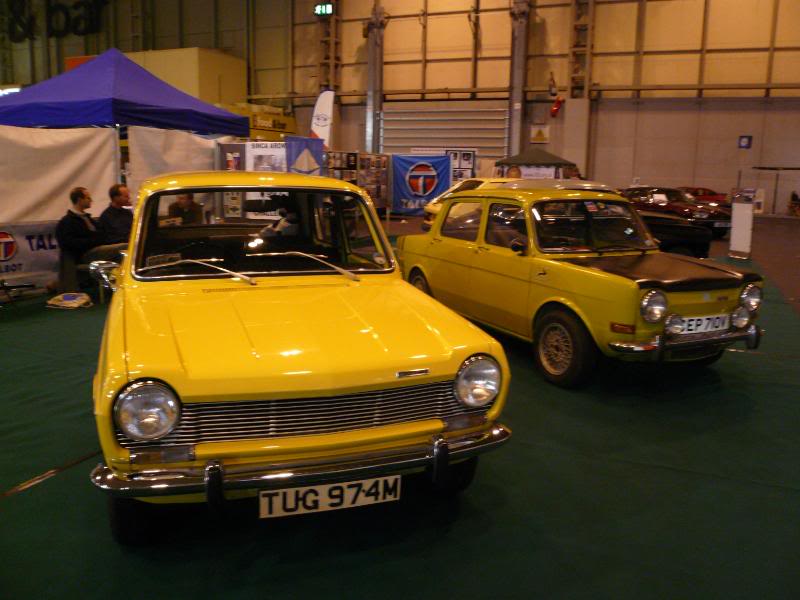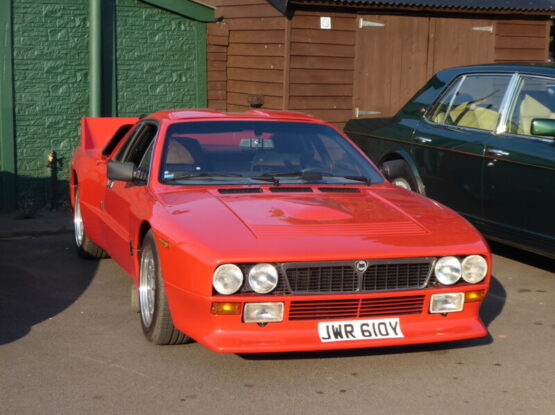The International Classic Car show event at the NEC is now by far the largest show of its kind in the UK, filling 4 giant exhibition halls with an incredible diversity of cars, ranging from some very familiar models to some rarities, and mixing prized possessions with those which are for sale. Having learned from visits in the previous couple of years that it is impossible to see the whole show in a single day, I decided to add a Friday to the Forum’s planned Saturday attendance, and was hopeful of a quiet day. Not so, with surprisingly large crowds to contend with, including an unexpected number of children who were clearly not at school, either officially or unofficially. With such a lot to see, it was never likely that the camera would capture everything, but here, sequenced by marque are some of the cars which I did photograph. I have grouped them together by manufacturer, even though this does not necessarily represent the individual stands on which the cars were to be found.
ALFA ROMEO Highlight here was an 8C Competitzione, in red. It remained so crowded, that there is no picture to show. There were disappointingly few cars on the rest of the stand, just these three that were captured by my camera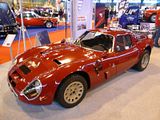
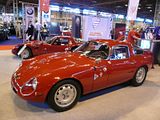
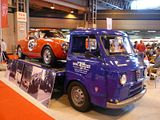 ASTON MARTIN One of the rare Zagato Volantes
ASTON MARTIN One of the rare Zagato Volantes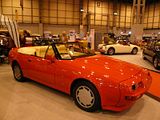 AUDI It was with the Quattro that Audi really gained huge public interest, and examples of both rally and road car were on show
AUDI It was with the Quattro that Audi really gained huge public interest, and examples of both rally and road car were on show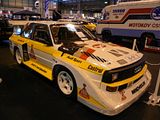 One of the more recent cars on display, an 80 Cabriolet
One of the more recent cars on display, an 80 Cabriolet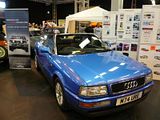 AUSTIN A large stand from the Austin Seven Owners club had a good range of these still popular vehicles on show.
AUSTIN A large stand from the Austin Seven Owners club had a good range of these still popular vehicles on show.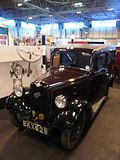

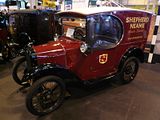

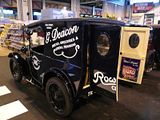

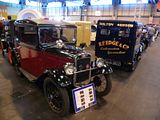
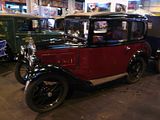
 Top of the Austin tree in the mid 1950s were the A125 and 135 Sheerline and Princess cars:
Top of the Austin tree in the mid 1950s were the A125 and 135 Sheerline and Princess cars: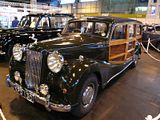
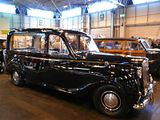
 The Maxi exemplifies all that was wrong with BMC and British Leyland: ingenious design ruined by poor execution and shoddy build quality. These are a couple of the early cars
The Maxi exemplifies all that was wrong with BMC and British Leyland: ingenious design ruined by poor execution and shoddy build quality. These are a couple of the early cars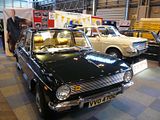
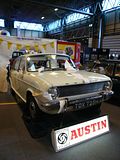 Even more notorious, perhaps, is the Allegro. Nonetheless, this car, so often vilified, has an enthusiastic owners club.
Even more notorious, perhaps, is the Allegro. Nonetheless, this car, so often vilified, has an enthusiastic owners club.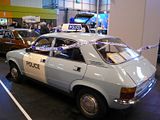
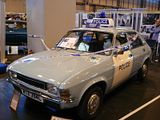
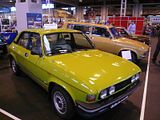 This car, an early 1750SS model was recently featured in Classic Monthly magazine, and is the proud possession of the Rev Colin Corke. I first met him when I was a student (we were in the same college at Durham), and was pleased to get the chance to catch up with him in person on the stand, and to listen to some of the tales of the restoration of this car. Not to everyone’s taste, perhaps, but few can deny the quality of the end result, and the 10 second 0 – 60 time will shock many people who are used to more pedestrian versions of the car
This car, an early 1750SS model was recently featured in Classic Monthly magazine, and is the proud possession of the Rev Colin Corke. I first met him when I was a student (we were in the same college at Durham), and was pleased to get the chance to catch up with him in person on the stand, and to listen to some of the tales of the restoration of this car. Not to everyone’s taste, perhaps, but few can deny the quality of the end result, and the 10 second 0 – 60 time will shock many people who are used to more pedestrian versions of the car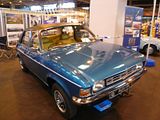
 The Maestro – once seen as the potential saviour of Austin-Rover – was launched in 1983, some 25 years ago, and now has an owners club all of its own
The Maestro – once seen as the potential saviour of Austin-Rover – was launched in 1983, some 25 years ago, and now has an owners club all of its own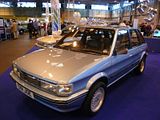
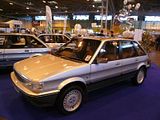
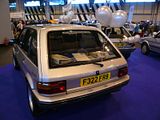
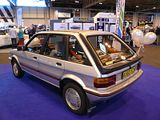 A small display of commercial vans from the 1950s – once a common sight, these vehicles long since disappeared from our roads:
A small display of commercial vans from the 1950s – once a common sight, these vehicles long since disappeared from our roads: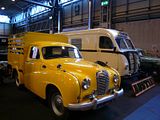
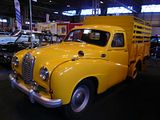
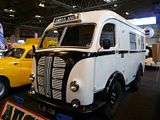 AUSTIN-HEALEYA charming display of “Frog-eyed” Sprites, in celebration of the 50th anniversary of the launch of this popular sports car:
AUSTIN-HEALEYA charming display of “Frog-eyed” Sprites, in celebration of the 50th anniversary of the launch of this popular sports car:
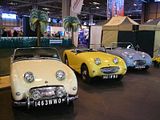
BEDFORD The CA Van was a popular choice in the 1950s and 1960s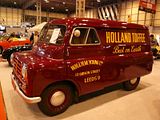 It was not just a utility vehicle, as many were converted into a motor caravan, such as this Dormobile version.
It was not just a utility vehicle, as many were converted into a motor caravan, such as this Dormobile version. Rather than produce a conventional estate model of the Viva, Vauxhall decided to launch a passenger version of the Bedford Van, a vehicle they called the Beagle. In some ways, this can be construed as the forerunner to vehicles like the Kangoo, Berlingo and Doblo.
Rather than produce a conventional estate model of the Viva, Vauxhall decided to launch a passenger version of the Bedford Van, a vehicle they called the Beagle. In some ways, this can be construed as the forerunner to vehicles like the Kangoo, Berlingo and Doblo.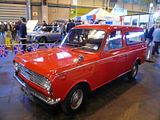
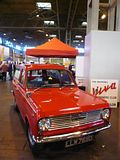
BITTER A little known German marque, who built luxury tourers based on Opel components. The first car was the Diplomat-based CD
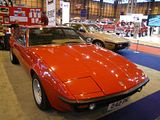 In the 1980s, the SC model appeared, based on a Senator
In the 1980s, the SC model appeared, based on a Senator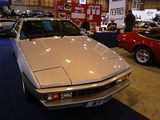

 BMW A small stand, and surprisingly unvisited until I pointed the camera, and then there seemed to be a steady stream of visitors!2002 Turbo
BMW A small stand, and surprisingly unvisited until I pointed the camera, and then there seemed to be a steady stream of visitors!2002 Turbo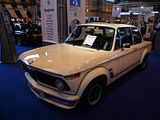
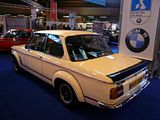 3.0 CSL
3.0 CSL 635CSI
635CSI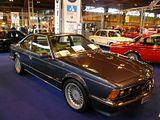 A 318iS, absolutely immaculate
A 318iS, absolutely immaculate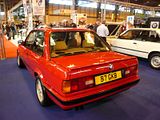
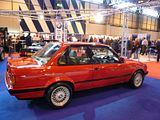 E30 model M3s
E30 model M3s
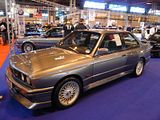 The Z1
The Z1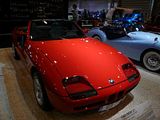 BRISTOL A three car stand. The Fighter remained crowded, so no pictures. The 405 – only 4 door saloon ever made by Bristol
BRISTOL A three car stand. The Fighter remained crowded, so no pictures. The 405 – only 4 door saloon ever made by Bristol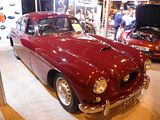
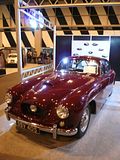 The later 411
The later 411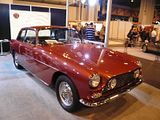 BUBBLE CARS
BUBBLE CARS
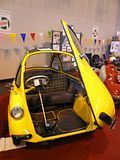
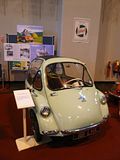
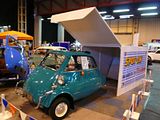
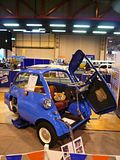
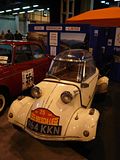 CITROEN A splendid set of cars, unsurprisingly. A big showing from the Traction Avant Club
CITROEN A splendid set of cars, unsurprisingly. A big showing from the Traction Avant Club
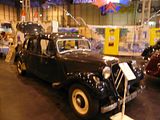
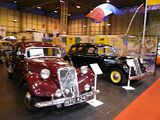
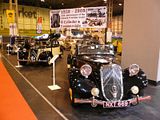
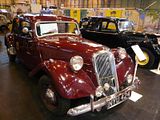 The earliest car on show was a 5CV from the early 1920s
The earliest car on show was a 5CV from the early 1920s
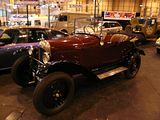
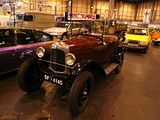 There were plenty of 2CVs, celebrating the 60th anniversary of the “Tin Snail”
There were plenty of 2CVs, celebrating the 60th anniversary of the “Tin Snail”
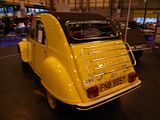
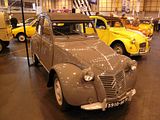
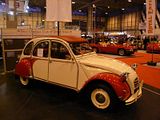
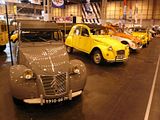
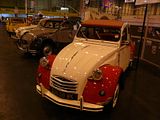 A rare GS Break model
A rare GS Break model
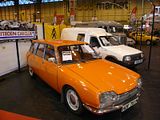 Just as rare these days, an early Visa
Just as rare these days, an early Visa
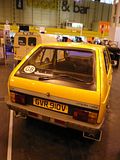


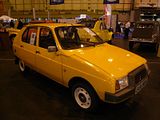 There were some other rare vehicles, too, like this one
There were some other rare vehicles, too, like this one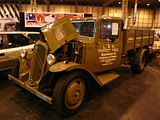
DAIMLER Several examples of the SP250, otherwise known as the Dart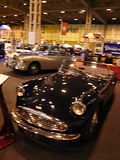
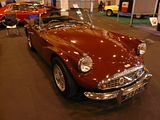
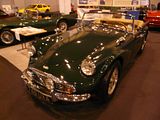 The 2.5 litre, a V8 engined version of the much loved Mark 2
The 2.5 litre, a V8 engined version of the much loved Mark 2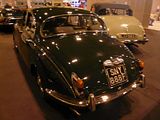
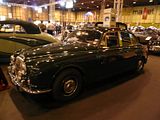 Majestic and Majestic Major
Majestic and Majestic Major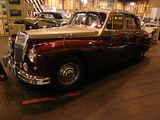
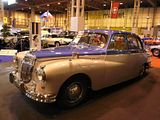 Sovereign, a close relative of the 420G
Sovereign, a close relative of the 420G Back in the 30s
Back in the 30s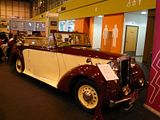 A prototype based on the XJ-S
A prototype based on the XJ-S
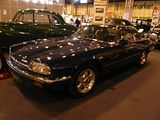 DKW Part of the Auto Union Group, the marque that became known as Audi, these cars from the 30s were among the rarer vehicles on show
DKW Part of the Auto Union Group, the marque that became known as Audi, these cars from the 30s were among the rarer vehicles on show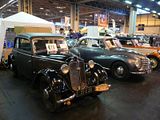

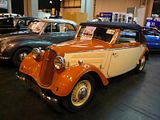 FERRARI The Ferrari Owners Club had a spacious stand in the middle of one of the halls, where several beauties from their heritage could be admired: Daytona:
FERRARI The Ferrari Owners Club had a spacious stand in the middle of one of the halls, where several beauties from their heritage could be admired: Daytona:
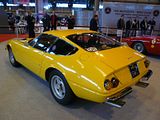 275GTS
275GTS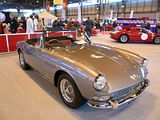
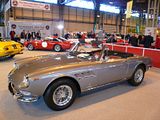 365 GTC/4
365 GTC/4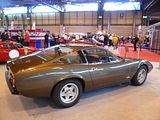
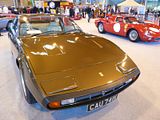 250 Le Mans
250 Le Mans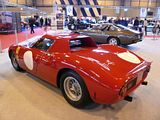 F355
F355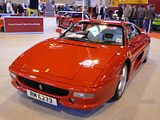 F40
F40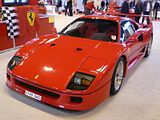
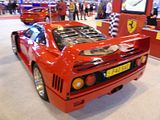 250 GT
250 GT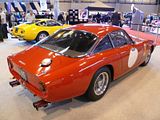
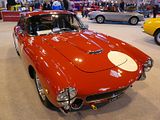 Elsewhere was this 360 Modena
Elsewhere was this 360 Modena 512 TR
512 TR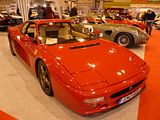 250
250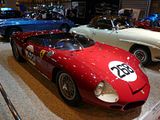 FIAT Just a small floor area, with only half a dozen cars.Tipo Sedicivalvolve
FIAT Just a small floor area, with only half a dozen cars.Tipo Sedicivalvolve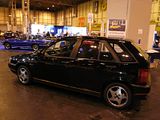 The Strada 105TC
The Strada 105TC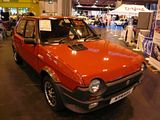 The 127 Sport
The 127 Sport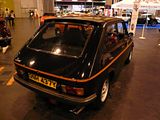
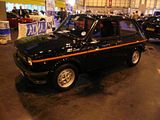 Nuova 500
Nuova 500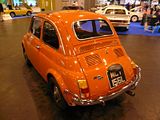 The 500C
The 500C FORD A vast array of different Fords were on show, some more “original” than others. The earliest cars were shown by the Model A Club
FORD A vast array of different Fords were on show, some more “original” than others. The earliest cars were shown by the Model A Club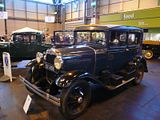
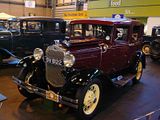
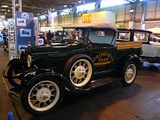
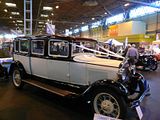
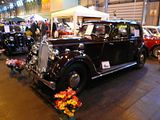 As Ford got established in the UK in the 1930s, they needed some smaller and cheaper cars, and the result was the Model C and the Model Y, like this one
As Ford got established in the UK in the 1930s, they needed some smaller and cheaper cars, and the result was the Model C and the Model Y, like this one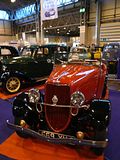 In the 1950s, the small car range was comprised of the Popular, Anglia and Prefect, like these:
In the 1950s, the small car range was comprised of the Popular, Anglia and Prefect, like these: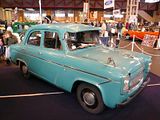
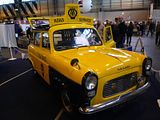 The larger cars comprised the Consul, Zephyr and Zodiac. These are Mark 3 cars:
The larger cars comprised the Consul, Zephyr and Zodiac. These are Mark 3 cars: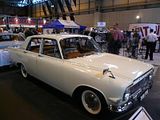
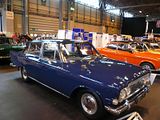
 The 1959 Anglia was the mainstay of the small car range in the early 1960s. Very basic looking now, these cars sold well to “reps”
The 1959 Anglia was the mainstay of the small car range in the early 1960s. Very basic looking now, these cars sold well to “reps”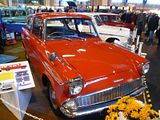
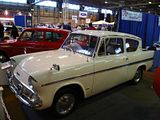
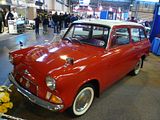 Innocenti had a go at restyling the Anglia and this is the result
Innocenti had a go at restyling the Anglia and this is the result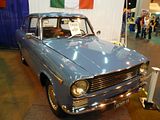
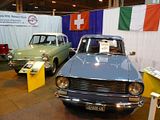 It was the launch of the Cortina. in 1962, that really transformed Ford’s fortunes in the UK market. Developed over 4 generations and 20 years, this car became the best seller of the nation.
It was the launch of the Cortina. in 1962, that really transformed Ford’s fortunes in the UK market. Developed over 4 generations and 20 years, this car became the best seller of the nation.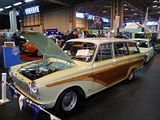
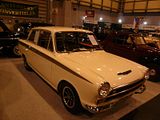
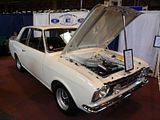
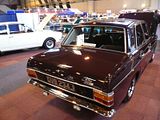
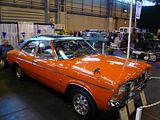 The Corsair was an upper medium sized range of cars launched in 1963, which never enjoyed the same level of success as the Cortina.
The Corsair was an upper medium sized range of cars launched in 1963, which never enjoyed the same level of success as the Cortina.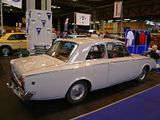 Although the majority of cars sold were 2 and 4 door saloons, there were a small number of Crayford-converted convertibles, and some rare estate cars.
Although the majority of cars sold were 2 and 4 door saloons, there were a small number of Crayford-converted convertibles, and some rare estate cars.
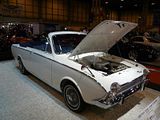
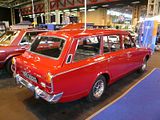 The Capri was launched in 1969 (and so we can expect lots of 40th anniversary celebration events next year), as “the car you promised yourself”. In reality, it was a Cortina dressed in a stylish coupe body, and offered in a bewildering array of different models and options
The Capri was launched in 1969 (and so we can expect lots of 40th anniversary celebration events next year), as “the car you promised yourself”. In reality, it was a Cortina dressed in a stylish coupe body, and offered in a bewildering array of different models and options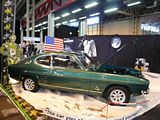
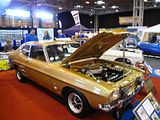
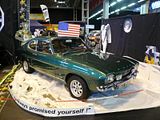
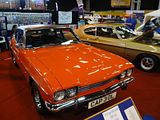 The second generation Capri, arriving in 1974 had the added practicality of a hatchback.
The second generation Capri, arriving in 1974 had the added practicality of a hatchback.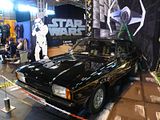 The third generation model came in 1978, and represented a careful evolution of the Mark 2.
The third generation model came in 1978, and represented a careful evolution of the Mark 2.
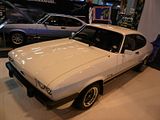
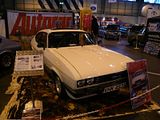 In 1983, Tickford made an attempt to take the car massively upmarket. Not a success
In 1983, Tickford made an attempt to take the car massively upmarket. Not a success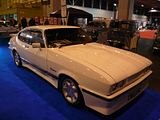 Hard to believe. but the first Fiesta appeared in the summer of 1976. This was the first front wheel drive offering from Ford UK, and the first hatchback. It was an immediate success. This car is believed to be the oldest UK example in existence, the 14th off the line, in January 1977. A basic 957 model, with a few “luxury” optional extras such as a locking fuel cap. Basic is certainly the order of the day!
Hard to believe. but the first Fiesta appeared in the summer of 1976. This was the first front wheel drive offering from Ford UK, and the first hatchback. It was an immediate success. This car is believed to be the oldest UK example in existence, the 14th off the line, in January 1977. A basic 957 model, with a few “luxury” optional extras such as a locking fuel cap. Basic is certainly the order of the day!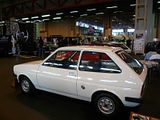

 It was not long before more sporting variants of the Fiesta arrived, and the XR2 was a huge success in the 1980s, appealing to the sort of target customer who 20 years earlier would doubtless have bought a Midget or a Sprite. This is a rare example of a facelifted Mark 1, in original condition.
It was not long before more sporting variants of the Fiesta arrived, and the XR2 was a huge success in the 1980s, appealing to the sort of target customer who 20 years earlier would doubtless have bought a Midget or a Sprite. This is a rare example of a facelifted Mark 1, in original condition.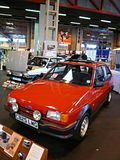
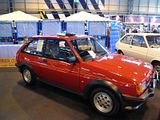 By this time, the Escort was long established, and built a reputation not just as a small family car, but on race track and rally stage as well.
By this time, the Escort was long established, and built a reputation not just as a small family car, but on race track and rally stage as well. 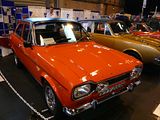
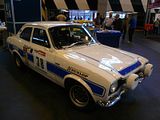
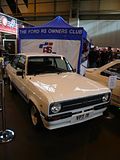 The Granada range first appeared in 1972.
The Granada range first appeared in 1972. This is a second generation car:
This is a second generation car: An RS200
An RS200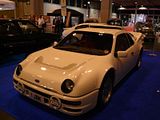
GORDON KEEBLE Two examples of this elegant GT were on show. Less than 100 cars were built, and virtually all of them have survived.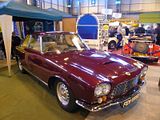 HEALEY The 1948 Elliott
HEALEY The 1948 Elliott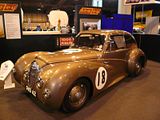 HEARSES One of the more unusual displays was one of a series of hearses from various different countries. Rarest to UK eyes was the 1963 model based on the Fiat 2300
HEARSES One of the more unusual displays was one of a series of hearses from various different countries. Rarest to UK eyes was the 1963 model based on the Fiat 2300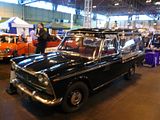
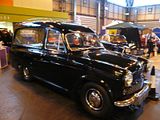 HILLMAN The name Minx goes back to the 1930s, as this car shows
HILLMAN The name Minx goes back to the 1930s, as this car shows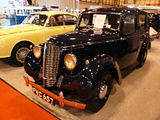
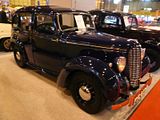 The conventional Hunter saloon was launched in 1966, as a competitor to the Cortina. Its image took a massive leap when the car won the London-Sydney Marathon in 1968:
The conventional Hunter saloon was launched in 1966, as a competitor to the Cortina. Its image took a massive leap when the car won the London-Sydney Marathon in 1968: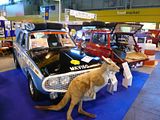
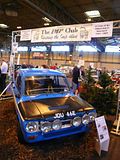 This Commer Van would have been a typical sort of support vehicle
This Commer Van would have been a typical sort of support vehicle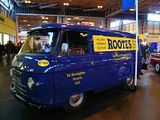 A cheaper model was launched in 1970: the Avenger. In an effort to inject some panache into the range, the rather garish Tiger model was produced in small quantities in 1973:
A cheaper model was launched in 1970: the Avenger. In an effort to inject some panache into the range, the rather garish Tiger model was produced in small quantities in 1973: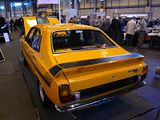
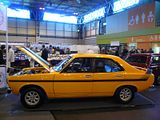 Rather bigger seller was the estate car, few of which have survived
Rather bigger seller was the estate car, few of which have survived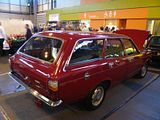 Avenger formed the basis for a much needed hatchback, but with rear wheel drive, it was never likely to have the success of the Fiesta, R5 and Fiat 127:
Avenger formed the basis for a much needed hatchback, but with rear wheel drive, it was never likely to have the success of the Fiesta, R5 and Fiat 127: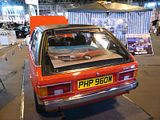
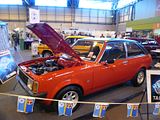 HONDA The S800s and Beat seemed to have eluded my camera, but I did capture this, the NS-X:
HONDA The S800s and Beat seemed to have eluded my camera, but I did capture this, the NS-X: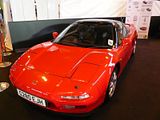
HUMBER 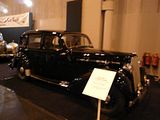
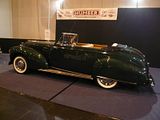
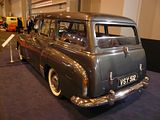
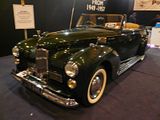 JAGUAR A comprehensive display of cars from the Jaguar-Daimler Heritage CollectionAn early XJ6
JAGUAR A comprehensive display of cars from the Jaguar-Daimler Heritage CollectionAn early XJ6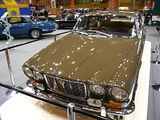 A Series 2 XJ Coupe
A Series 2 XJ Coupe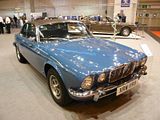 Series 3 XJ
Series 3 XJ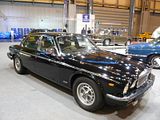 Bang uptodate
Bang uptodate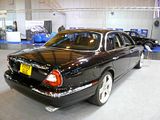 A prototype XJ40 Coupe
A prototype XJ40 Coupe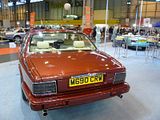
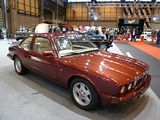 The Daimler Corsica convertible
The Daimler Corsica convertible There was a separate stand for the XJ-S, a car now being fully appreciated for what it is: a true grand tourer
There was a separate stand for the XJ-S, a car now being fully appreciated for what it is: a true grand tourer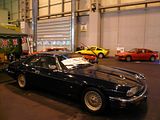

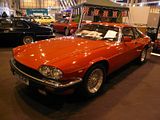
 Of course, the “E” type is always a popular car at these events, and there were several all over the show
Of course, the “E” type is always a popular car at these events, and there were several all over the show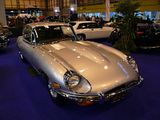 XK140
XK140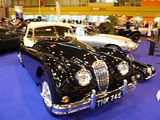 XK150
XK150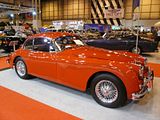 Mark 2
Mark 2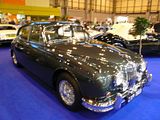 Mark IX
Mark IX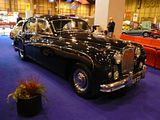
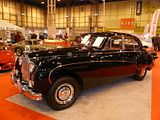 JENSEN The CV8
JENSEN The CV8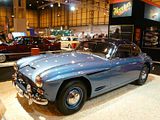
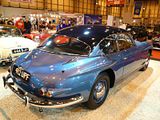 An example of the still rather elegant Interceptor.
An example of the still rather elegant Interceptor.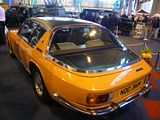 LAMBORGHINI Found on the “Tom Hartley” stand, with sales staff hoping for a buyer, was this Gallardo.
LAMBORGHINI Found on the “Tom Hartley” stand, with sales staff hoping for a buyer, was this Gallardo.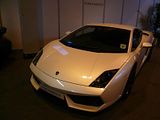 This Countach featured on the Classic and Sports Car stand
This Countach featured on the Classic and Sports Car stand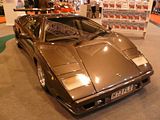 LANCIA A big stand, with lots to see. One part of it was given over to the Beta, and every model, apart from the less than elegant Trevi was on show:
LANCIA A big stand, with lots to see. One part of it was given over to the Beta, and every model, apart from the less than elegant Trevi was on show: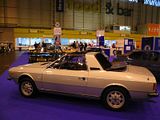
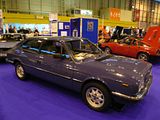

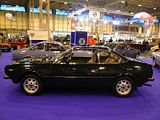

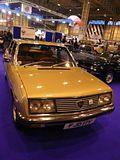
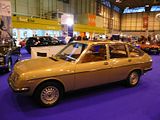
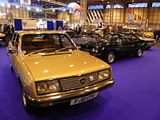
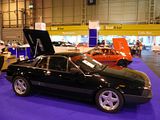 An earlier offering was the Fulvia, shown here in 2C Berlina form
An earlier offering was the Fulvia, shown here in 2C Berlina form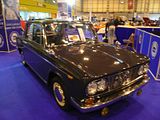
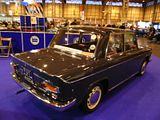 Earlier still came the Appia, and a coupe version of this car was shown.
Earlier still came the Appia, and a coupe version of this car was shown.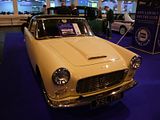

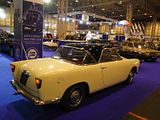
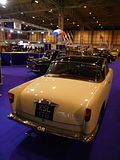
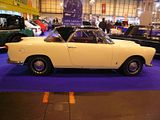 The Fulvia Zagato
The Fulvia Zagato The Stratos
The Stratos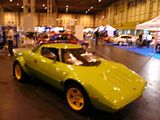 Other stand vehicles included a Lambda Limousine
Other stand vehicles included a Lambda Limousine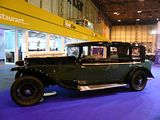
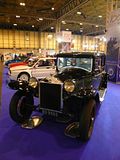 A Kappa Coupe
A Kappa Coupe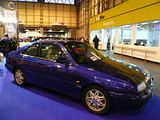 Flaminia Coupe
Flaminia Coupe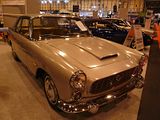 An example of the non-Integrale Delta
An example of the non-Integrale Delta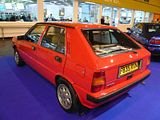 Bang up to date, the new Delta was also on display.
Bang up to date, the new Delta was also on display.
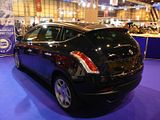
LAND ROVER A comprehensive display of Series 1 Land Rovers was the highlight of this stand: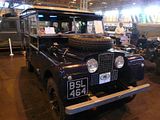

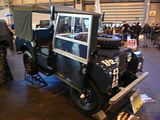 There were also several Range Rovers, mostly from the first generation. This is a later model:
There were also several Range Rovers, mostly from the first generation. This is a later model: This is one of the very early models, before the car became the luxury item that it is now.
This is one of the very early models, before the car became the luxury item that it is now.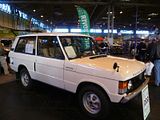 MARCOS A bit like the cat with nine lives, this make kept staging a reappearance in the 80s, 90s and this decade, but appears to have gone now for good. There were a mix of cars on the stand, ranging from the original 1800 and 3 litres to the more recent Mantara cars.
MARCOS A bit like the cat with nine lives, this make kept staging a reappearance in the 80s, 90s and this decade, but appears to have gone now for good. There were a mix of cars on the stand, ranging from the original 1800 and 3 litres to the more recent Mantara cars.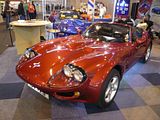
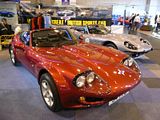
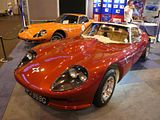
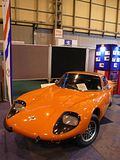
MASERATI Good to see a marque that not that long ago was in the doldrums had a large stand, and lots of people finding plenty of interest:Biturbo Karif
Karif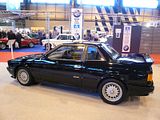
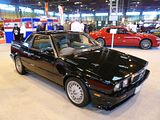 Ghibli
Ghibli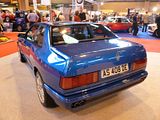
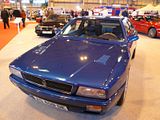
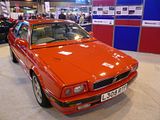 Quattroporte
Quattroporte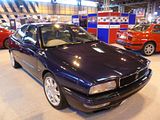
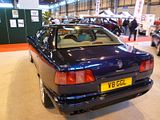 3200GT
3200GT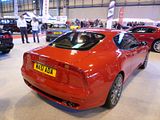
MATRA Four cars on show here, illustrating the three generations of medium sized sports coupe that this French maker offered.The Djet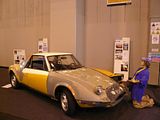 The Bagheera
The Bagheera The short-lived Murena
The short-lived Murena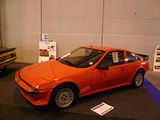
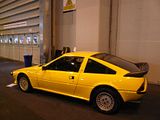
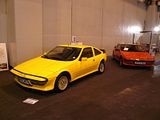 MERCEDES-BENZ Centrepiece of the Mercedes Owners Club display were 2 of the 300SL models, a Gullwing and a Hardtop
MERCEDES-BENZ Centrepiece of the Mercedes Owners Club display were 2 of the 300SL models, a Gullwing and a Hardtop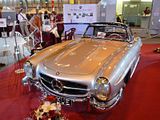
 A large number of the cars for sale were Mercedes, and few are more desirable than the R107 SL models such as these. Just gorgeous!
A large number of the cars for sale were Mercedes, and few are more desirable than the R107 SL models such as these. Just gorgeous!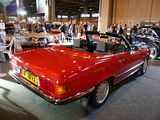
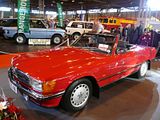
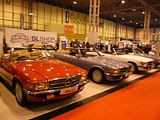
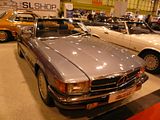 The less common SLC
The less common SLC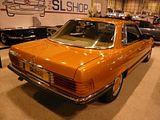 The 220 “ponton”
The 220 “ponton”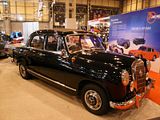 METROPOLITAN These brightly coloured cars were primarily intended for the US market, where the initial 1250cc engine proved rather too weedy. Even with the later 1489cc B Series engine, performance was never a strong suit.
METROPOLITAN These brightly coloured cars were primarily intended for the US market, where the initial 1250cc engine proved rather too weedy. Even with the later 1489cc B Series engine, performance was never a strong suit.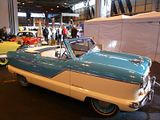
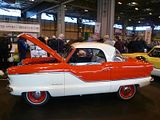
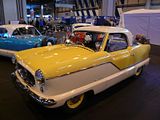
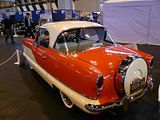
MG The MG TC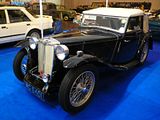 This MGA comes from the 1950s
This MGA comes from the 1950s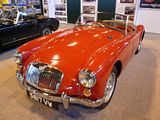 The Midget had a long production life, from 1961 to 1979
The Midget had a long production life, from 1961 to 1979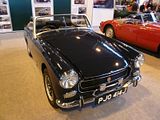
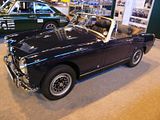 Purists will never really accept the MG models from the 1980s, but they kept the brand alive. These Maestros were actually good cars, with a poor reputation.
Purists will never really accept the MG models from the 1980s, but they kept the brand alive. These Maestros were actually good cars, with a poor reputation.
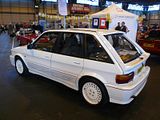
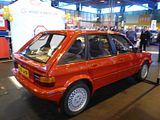
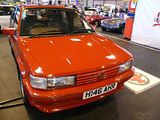
MINI There will be big celebrations in 2009, to mark the 50th anniversary of this well loved car. These are Cooper models: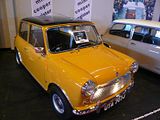
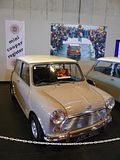
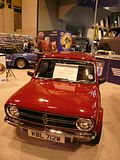 MORRIS A couple of rather nice Morris 8 cars from the mid 1930s
MORRIS A couple of rather nice Morris 8 cars from the mid 1930s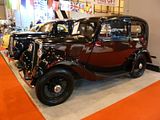
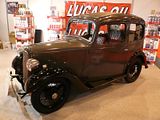 The focus of the main Morris display was around the cars available in the late 1940s and early 1950s and then a whole series of different Minors, a car celebrating its 60th anniversary this year. This is the Oxford from the 1940s
The focus of the main Morris display was around the cars available in the late 1940s and early 1950s and then a whole series of different Minors, a car celebrating its 60th anniversary this year. This is the Oxford from the 1940s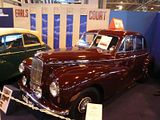 Its replacement, the MO model,
Its replacement, the MO model,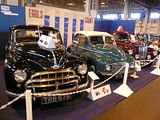 Here are the Minors
Here are the Minors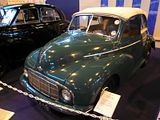
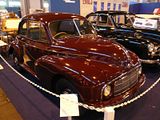
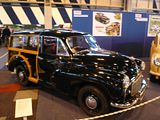
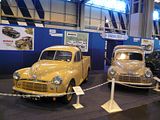

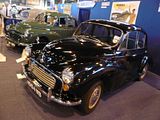
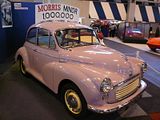
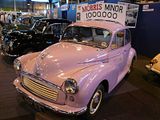

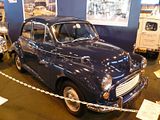 In the early 1950s, the Morris J Van was a stalwart of the local tradesmen. The first ohv models were blessed with just 14 bhp and a 3 speed gearbox. Engines had a life of only about 40,000 miles. No wonder one of the people I spoke with on the stand said he had not brought his the 100 miles from home – it would have taken him many hours.
In the early 1950s, the Morris J Van was a stalwart of the local tradesmen. The first ohv models were blessed with just 14 bhp and a 3 speed gearbox. Engines had a life of only about 40,000 miles. No wonder one of the people I spoke with on the stand said he had not brought his the 100 miles from home – it would have taken him many hours.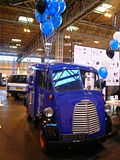
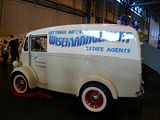
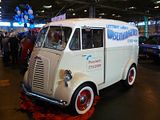
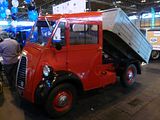 NAYLOR A brave attempt to recreate the legendary MG TF, but with the benefit of modern mechanicals, a few of these cars were sold in the mid 1980s
NAYLOR A brave attempt to recreate the legendary MG TF, but with the benefit of modern mechanicals, a few of these cars were sold in the mid 1980s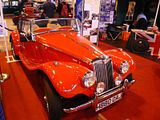 NISSAN Unsurprisingly, the Z car was the main focus for Nissan. This is a very early car, lacking the rear spoiler which was added within months of imports starting:
NISSAN Unsurprisingly, the Z car was the main focus for Nissan. This is a very early car, lacking the rear spoiler which was added within months of imports starting:
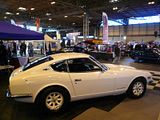 A small area had been claimed by the Cedric and Gloria Owners Club for these rather chintzy top of the range cars. This one, a 2000 Gloria, was imported from Zimbabwe and appears to be a regular at shows, as I have seen it at least twice already in 2008:
A small area had been claimed by the Cedric and Gloria Owners Club for these rather chintzy top of the range cars. This one, a 2000 Gloria, was imported from Zimbabwe and appears to be a regular at shows, as I have seen it at least twice already in 2008:
 The 260C from 1977:
The 260C from 1977:
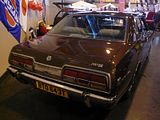 The last of the line that was imported to the UK, the 300C from the mid 1980s
The last of the line that was imported to the UK, the 300C from the mid 1980s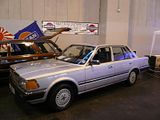
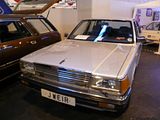 There was also an estate version
There was also an estate version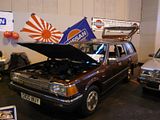 OPELThe 1978 Senator and Monza came as quite a shock, as they were truly good cars – not something which had ever been said about the previous top end Opel models. Now affectionately known as the “autobahn stormers”, an example of each was on show
OPELThe 1978 Senator and Monza came as quite a shock, as they were truly good cars – not something which had ever been said about the previous top end Opel models. Now affectionately known as the “autobahn stormers”, an example of each was on show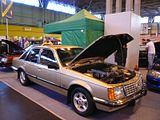
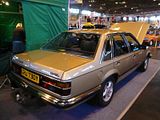
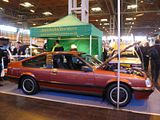 PANTHER A wide-ranging display of cars from a manufacturer that blossomed in the 1970s with a series of pastiche and retro cars. Best known of these was the J72, which was loosely based on the 1930s SS100 Jaguar.
PANTHER A wide-ranging display of cars from a manufacturer that blossomed in the 1970s with a series of pastiche and retro cars. Best known of these was the J72, which was loosely based on the 1930s SS100 Jaguar.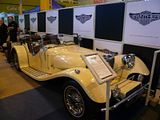 However, they caused a real sensation at the MotorFair of 1977, with the unveiling of the 6 wheeler Panther Six.. Powered by an 8.2 litre Cadillac engine, only 2 of these cars were ever constructed.
However, they caused a real sensation at the MotorFair of 1977, with the unveiling of the 6 wheeler Panther Six.. Powered by an 8.2 litre Cadillac engine, only 2 of these cars were ever constructed.
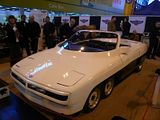
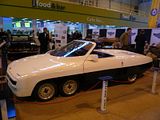 The Rio was made for a couple of years – based on a Triumph Dolomite, and sold for more than twice the cost of the donor car, only around 100 were sold.
The Rio was made for a couple of years – based on a Triumph Dolomite, and sold for more than twice the cost of the donor car, only around 100 were sold. The Lima, based on Vauxhall Magnum components was far more successful.
The Lima, based on Vauxhall Magnum components was far more successful.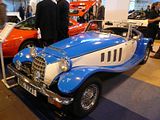 Panther’s finale came with the Solo, a car that took a long time to launch, was widely praised by the motoring press, but which sank after a mere 30 had been made.
Panther’s finale came with the Solo, a car that took a long time to launch, was widely praised by the motoring press, but which sank after a mere 30 had been made.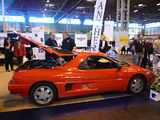
PEUGEOT Just a small stand area. Pride of place went to a 302 Darlmat car from the fabulous “Aventure Peugeot” collection.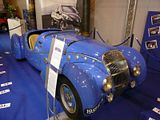 The 205 T16 looks quite uncanny, even now, 25 years after it first appeared.
The 205 T16 looks quite uncanny, even now, 25 years after it first appeared. 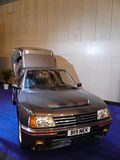
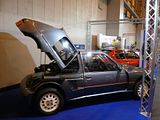 Rare to see an immaculate and original 205 GTi, but there were a couple to complete the stand
Rare to see an immaculate and original 205 GTi, but there were a couple to complete the stand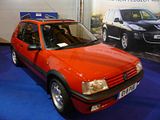 POLICE CARS A stand dedicated to restored police vehicles comprised, among others, these once familiar sights
POLICE CARS A stand dedicated to restored police vehicles comprised, among others, these once familiar sights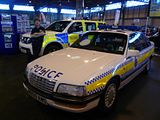
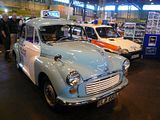

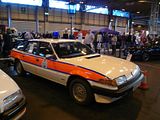
PORSCHE Part of a Shell stand, there was this VW-Porsche 914: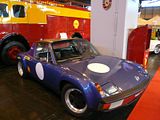

 Rather modern was this 911 Turbo
Rather modern was this 911 Turbo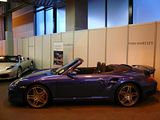 This 356 model is from the early days of Porsche
This 356 model is from the early days of Porsche And this is an early 911
And this is an early 911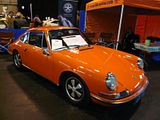 The forgotten model, the 914……. in excess of 100,000 of these were sold, mostly in America
The forgotten model, the 914……. in excess of 100,000 of these were sold, mostly in America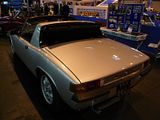
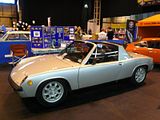 RILEY Riley had a strong reputation for sporting cars in the 1930s, and this example of the Kestrel could be seen as a sort of 3 series BMW of its time:
RILEY Riley had a strong reputation for sporting cars in the 1930s, and this example of the Kestrel could be seen as a sort of 3 series BMW of its time:
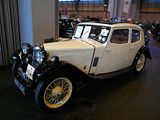 This was an even more overtly sporting offering:
This was an even more overtly sporting offering: Many will tell you that the RM series cars were the last real Rileys, as after this time, they became shared with other BMC models, and then simply badge engineered versions of Austin and Morris.
Many will tell you that the RM series cars were the last real Rileys, as after this time, they became shared with other BMC models, and then simply badge engineered versions of Austin and Morris.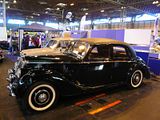 The Riley 1.5 was launched in 1957, a design intended to replace the Morris Minor, but which never got beyond this version and its Wolseley sister, in Europe.
The Riley 1.5 was launched in 1957, a design intended to replace the Morris Minor, but which never got beyond this version and its Wolseley sister, in Europe.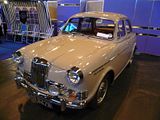 The Elf was a luxurious version of the Mini
The Elf was a luxurious version of the Mini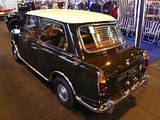
ROCHDALE A little known sports car from the early 1960s.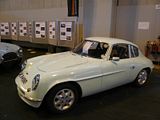
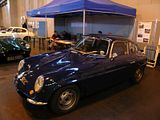
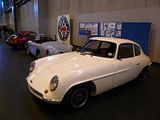
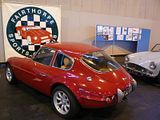 ROVER The P5 cars have acquired something of a cult following now, being seen as a true cut-price Rolls-Royce
ROVER The P5 cars have acquired something of a cult following now, being seen as a true cut-price Rolls-Royce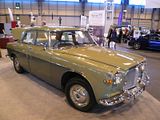
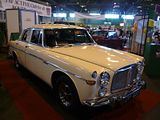 The next model, the P6 almost invented the executive sports saloon category that so dominates the midmarket these days.
The next model, the P6 almost invented the executive sports saloon category that so dominates the midmarket these days.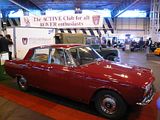 The SD1 of 1976 was initially hailed as a real sign that Britain could build a world beater. Sadly, the all too familiar problems of shoddy build quality were all too evident.
The SD1 of 1976 was initially hailed as a real sign that Britain could build a world beater. Sadly, the all too familiar problems of shoddy build quality were all too evident.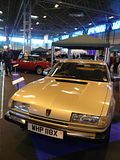
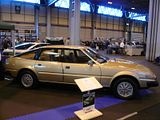 The replacement was the XX project, a joint venture with Honda, which led to the Rover 800, a capable car, but one which never caught the public’s imagination in the same way.
The replacement was the XX project, a joint venture with Honda, which led to the Rover 800, a capable car, but one which never caught the public’s imagination in the same way.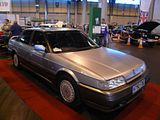 The R8-based cars, a close relative of the Honda Concerto, were extremely popular in the early 1990s, and deservedly so, too, I had a 414 Si model for three years and it was an excellent car. Here are three of the more unusual derivatives:
The R8-based cars, a close relative of the Honda Concerto, were extremely popular in the early 1990s, and deservedly so, too, I had a 414 Si model for three years and it was an excellent car. Here are three of the more unusual derivatives: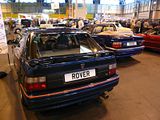
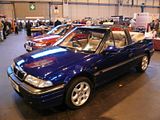
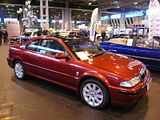 Looking a bit like the stand to go around the cars had failed to arrive, were these 200 BRMs.
Looking a bit like the stand to go around the cars had failed to arrive, were these 200 BRMs.

SAAB An early “people carrier”, the 7 seater 95 Estate
 SIMCA Some real rarities here. Not probably deemed very desirable by any but the true afficianado, but good to see, nonetheless. It’s hard to believe, but the Simca 1100 was the best selling car in France for many years, and it sold strongly in the UK, too. When did you last see one?
SIMCA Some real rarities here. Not probably deemed very desirable by any but the true afficianado, but good to see, nonetheless. It’s hard to believe, but the Simca 1100 was the best selling car in France for many years, and it sold strongly in the UK, too. When did you last see one?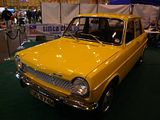
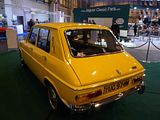
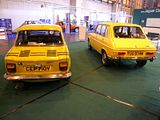

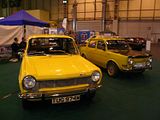 Its successor, the unloved Horizon actually won the Car of the Year award in 1978. Again, when did you last see one?
Its successor, the unloved Horizon actually won the Car of the Year award in 1978. Again, when did you last see one?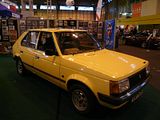
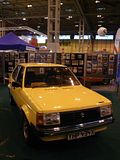
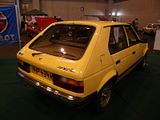
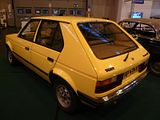
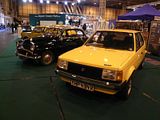
 The Simca Mille (1000) was honed into some fast (and rather scary) versions, like this Rallye.
The Simca Mille (1000) was honed into some fast (and rather scary) versions, like this Rallye.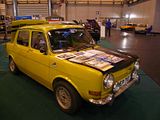
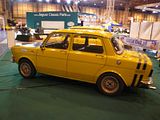 Completing the display was an Aronde from the late 1950s.
Completing the display was an Aronde from the late 1950s.
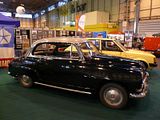
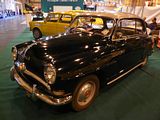
SKODA Not long ago, Skoda would have been confined to an obscure corner of the show, visited by few people, but now, there is renewed interest in cars of all generations from this proud Czech maker. The 1000MB was the first rear engined car, designed to copy the many rivals who switched to this format a couple of years earlier. The subsequent generation of model had more modern styling, and was offered as in coupe as well as saloon format
The subsequent generation of model had more modern styling, and was offered as in coupe as well as saloon format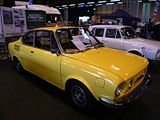 It was this car, the Rapid, that finally started to change people’s perceptions of the marque, when a road test car featured on the cover of “Autocar & Motor”, proclaimed as a cut-price Porsche 911.
It was this car, the Rapid, that finally started to change people’s perceptions of the marque, when a road test car featured on the cover of “Autocar & Motor”, proclaimed as a cut-price Porsche 911.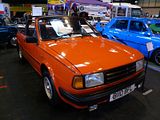
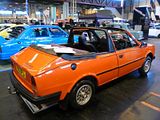 By this time, Skoda was starting to become known beyond its native land for success in rallying, with these cars taking class wins in the RAC Rally every year.
By this time, Skoda was starting to become known beyond its native land for success in rallying, with these cars taking class wins in the RAC Rally every year.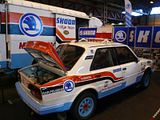 Actually, motor sport was not new to Skoda, as this car proves
Actually, motor sport was not new to Skoda, as this car proves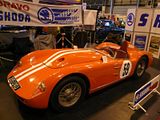 STANDARD A range of these cars from the 1950s were on show:The Pennant
STANDARD A range of these cars from the 1950s were on show:The Pennant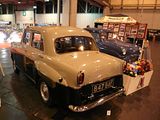
 The earlier Ten
The earlier Ten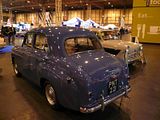
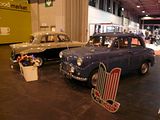 There were also commercial versions available, such as these:
There were also commercial versions available, such as these: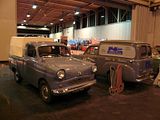
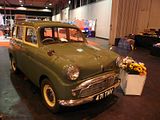 SUNBEAM and TALBOT A splendid display of sporting cars from the Rootes Group, many of which were badged Sunbeam or Talbot.
SUNBEAM and TALBOT A splendid display of sporting cars from the Rootes Group, many of which were badged Sunbeam or Talbot. The Alpine was a winner more than once of the Monte Carlo Rally
The Alpine was a winner more than once of the Monte Carlo Rally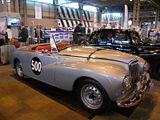
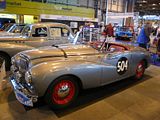 The Rapier, launched in 1955 as a coupe version of the Minx saloon, was a successful rally car in the late 1950s
The Rapier, launched in 1955 as a coupe version of the Minx saloon, was a successful rally car in the late 1950s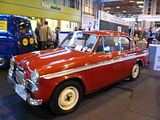
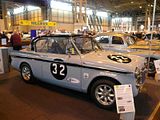 Later, the Alpine sports car was adapted to a role in motor sport:
Later, the Alpine sports car was adapted to a role in motor sport: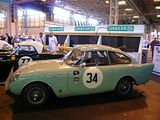 Last successful rally car from this marque was the Sunbeam Lotus, which was at its heyday in 1980
Last successful rally car from this marque was the Sunbeam Lotus, which was at its heyday in 1980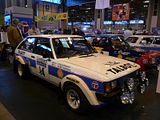
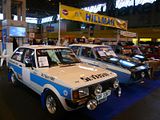
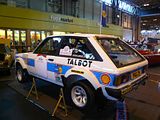 Support vehicle from the era was this Avenger Estate
Support vehicle from the era was this Avenger Estate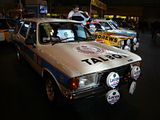
TATRA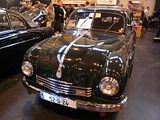

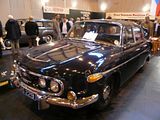

TRIUMPH Several different stands, representing the various clubs that cater for this much-missed marque. It was a pleasure to stop by the TR Register, not just to admire the cars, but to catch up with Dave Gibson, and to avail ourselves of the hospitality of a welcome cup of coffee. One of the very few genuine right hand drive TR8s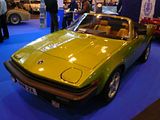 TR6
TR6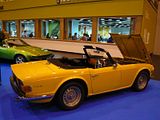 TS2, the first TR2 production car
TS2, the first TR2 production car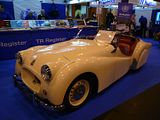 TR3
TR3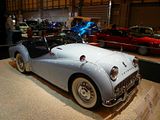 TR4
TR4 Stag
Stag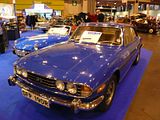
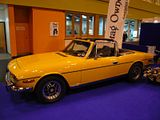 Vitesse
Vitesse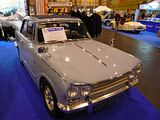 2000/2500 Saloons
2000/2500 Saloons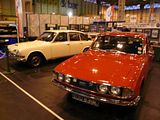
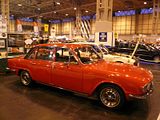 Dolomites
Dolomites
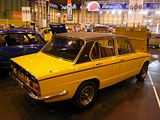
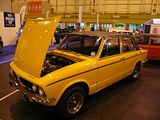
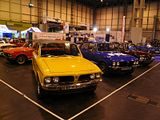
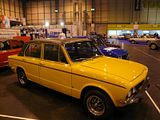 TOYOTA A display of early MR2s seemed to be the extent of classic cars from Japan’s largest manufacturer
TOYOTA A display of early MR2s seemed to be the extent of classic cars from Japan’s largest manufacturer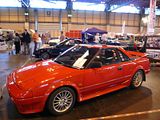
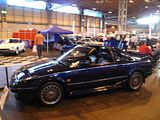 TURNER Another of those little known marques from the late 1950s and very early 1960s
TURNER Another of those little known marques from the late 1950s and very early 1960s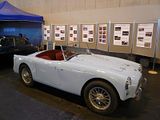
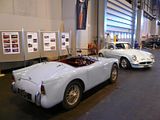
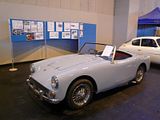 VAUXHALL This model dates from 1934, at which time, the pale blue colour was considered particularly “risque”
VAUXHALL This model dates from 1934, at which time, the pale blue colour was considered particularly “risque” Vauxhall’s answer to the Escort first appeared in 1963, and was called the Viva. The second generation model appeared just 3 years later:
Vauxhall’s answer to the Escort first appeared in 1963, and was called the Viva. The second generation model appeared just 3 years later: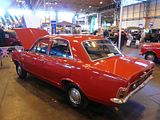 In 1970, yet another new version appeared, the HC model, which then lived throughout the whole of the 1970s.
In 1970, yet another new version appeared, the HC model, which then lived throughout the whole of the 1970s.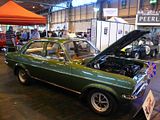
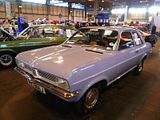
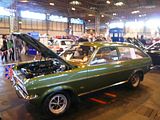
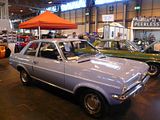
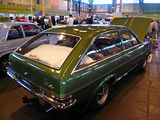
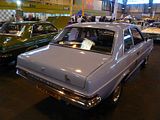 The 1967 FD range of Victor, VX4/90 and Ventora brought the “coke bottle” styling over the Atlantic to a popular British car, and also were one of the first volume sellers with an overhead cam engine.
The 1967 FD range of Victor, VX4/90 and Ventora brought the “coke bottle” styling over the Atlantic to a popular British car, and also were one of the first volume sellers with an overhead cam engine.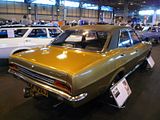

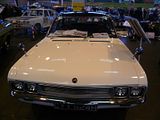
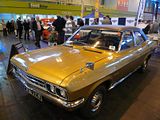
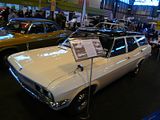 Vauxhall’s answer to the Capri was this, the Firenza, launched in 1971, but the car never enjoyed anything like the success of its main rival
Vauxhall’s answer to the Capri was this, the Firenza, launched in 1971, but the car never enjoyed anything like the success of its main rival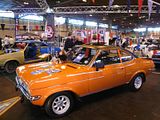 Before the real interest in convertibles gathered momentum, Vauxhall put a toe in the water with the Cavalier convertible in the 1980s
Before the real interest in convertibles gathered momentum, Vauxhall put a toe in the water with the Cavalier convertible in the 1980s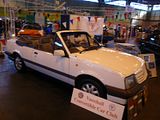
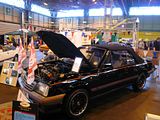
VOLKSWAGEN No surprise to find several examples of the Beetle on show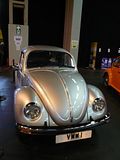
 The Karmann Ghia coupe and convertible cars were popular even when new, and now are highly prized
The Karmann Ghia coupe and convertible cars were popular even when new, and now are highly prized It was not long before some more extreme conversions started to appear, such as this Beach Buggy
It was not long before some more extreme conversions started to appear, such as this Beach Buggy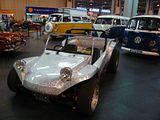 The Type 2 remains popular, even to this day:
The Type 2 remains popular, even to this day: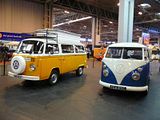
 Less successful was the Type 3, first introduced as a 1500 saloon in 1961
Less successful was the Type 3, first introduced as a 1500 saloon in 1961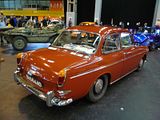 The legendary Golf needs no introduction. This was an early Mark 1:
The legendary Golf needs no introduction. This was an early Mark 1: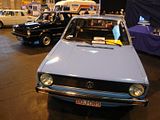 And a couple of first generation GTi cars.
And a couple of first generation GTi cars.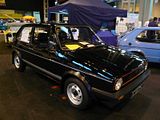 The Scirocco was the coupe version of the Golf back in the 1970s, and once again with the latest car, an example of which was hurriedly locked when too many people started prodding and poking too hard
The Scirocco was the coupe version of the Golf back in the 1970s, and once again with the latest car, an example of which was hurriedly locked when too many people started prodding and poking too hard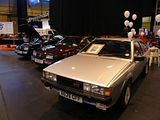
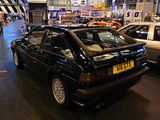

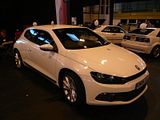 In the interim, there were Corrados, a car much praised but not bought in sufficient quantity at the time
In the interim, there were Corrados, a car much praised but not bought in sufficient quantity at the time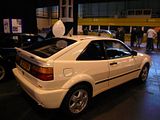
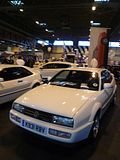
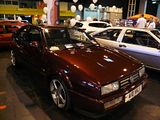
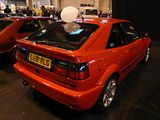 VOLVO Volvo Heritage had a huge stand as the centre piece of Hall1, with several cars brought over from Sweden, all finished in red.
VOLVO Volvo Heritage had a huge stand as the centre piece of Hall1, with several cars brought over from Sweden, all finished in red.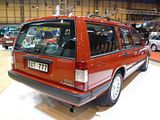

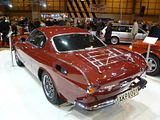
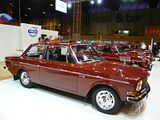

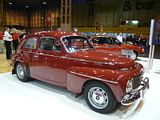
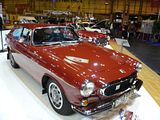
 This coupe was built for the president of Volvo, and rather than featuring the expected 6 cylinder engine, making it a 262C, it had a 4 cylinder turbo fitted.
This coupe was built for the president of Volvo, and rather than featuring the expected 6 cylinder engine, making it a 262C, it had a 4 cylinder turbo fitted.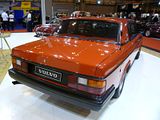

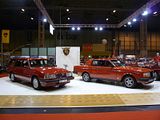 Elsewhere, this 244DL was a reminder of a once common workhorse
Elsewhere, this 244DL was a reminder of a once common workhorse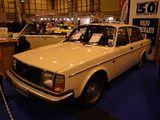 WOLSELEY A small display of three of these cars from the 1930s
WOLSELEY A small display of three of these cars from the 1930s
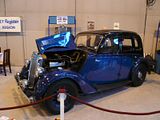
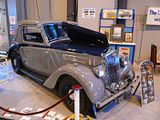 AMERICAN CARS There was a good variety of Classic American metal to be seen in Hall 4 1934 Nash
AMERICAN CARS There was a good variety of Classic American metal to be seen in Hall 4 1934 Nash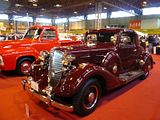 Ford F150 Pickup from 1956
Ford F150 Pickup from 1956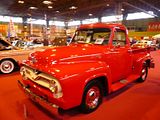 1971 Plymouth ‘Cuda Convertible
1971 Plymouth ‘Cuda Convertible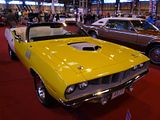 1973 Lincoln Convertible Mark IV
1973 Lincoln Convertible Mark IV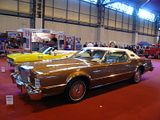 1966 Shelby Mustang 350GT-H
1966 Shelby Mustang 350GT-H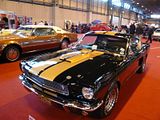 Corvette Stingray
Corvette Stingray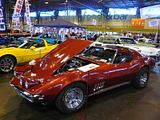 Corvette Mark IV
Corvette Mark IV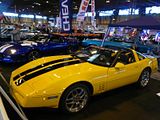 1959 Chevrolet Impala – when fins were at their zenith
1959 Chevrolet Impala – when fins were at their zenith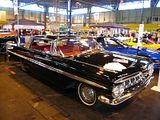 Mid 1960s Oldsmobile
Mid 1960s Oldsmobile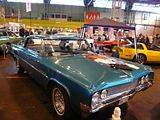 1957 Cadillac Fleetwood Seville
1957 Cadillac Fleetwood Seville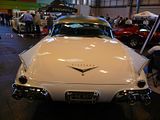
 1973 Plymouth Satellite
1973 Plymouth Satellite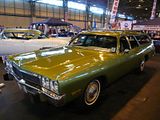
 Running at the same time as the Classic Car Show is the MPH08 and Top Gear Live series of performances. Although this was in the same hall as last year, and the stand layout was exactly the same, it just felt as if there was less to see in this exhibition. There were three types of stand with cars on them: manufacturers: stands offering expensive membership schemes to allow you to drive exotica; and a special enclosure for some nice cars ownd by celebrities. Starting with the manufacturers, the best was undoubtedly Jaguar, who had an XF in the same colour and the same place as last year. Still a good looking car:
Running at the same time as the Classic Car Show is the MPH08 and Top Gear Live series of performances. Although this was in the same hall as last year, and the stand layout was exactly the same, it just felt as if there was less to see in this exhibition. There were three types of stand with cars on them: manufacturers: stands offering expensive membership schemes to allow you to drive exotica; and a special enclosure for some nice cars ownd by celebrities. Starting with the manufacturers, the best was undoubtedly Jaguar, who had an XF in the same colour and the same place as last year. Still a good looking car: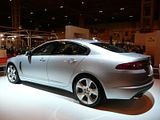
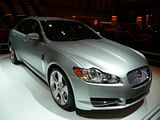 Citroen had a stand, and there was a desecrated C6 to try to ignore:
Citroen had a stand, and there was a desecrated C6 to try to ignore: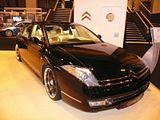 A nice car ruined! The C5 Tourer was altogether more restrained looking
A nice car ruined! The C5 Tourer was altogether more restrained looking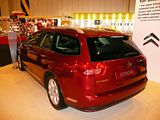
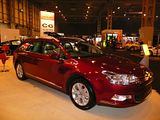 Volvo had the new XC60, but my camera never found it. Renault had a couple of new Meganes to inspect. Can’t help feeling that the styling of the 5 door is decidedly “euro-bland”, though there is no arguing with the improvement in feel of the interior quality:
Volvo had the new XC60, but my camera never found it. Renault had a couple of new Meganes to inspect. Can’t help feeling that the styling of the 5 door is decidedly “euro-bland”, though there is no arguing with the improvement in feel of the interior quality: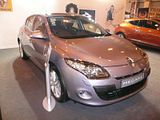 The Megane R26R was actually to be found on the Auto Express stand
The Megane R26R was actually to be found on the Auto Express stand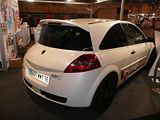 The recently relaunched MG TF LE500 was attracting precisely no-one on the Friday. Things were better on the Saturday, helped by the dishing out of carrier bags with a poster, stick on badge, balloon and cheap pen!
The recently relaunched MG TF LE500 was attracting precisely no-one on the Friday. Things were better on the Saturday, helped by the dishing out of carrier bags with a poster, stick on badge, balloon and cheap pen!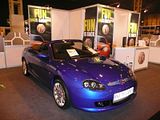 And so, onto the supercars:Gumpert Apollo
And so, onto the supercars:Gumpert Apollo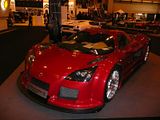
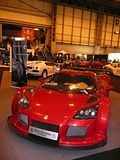 Salica
Salica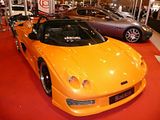 X-Bow
X-Bow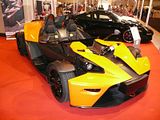 Mitsubishi Evo X
Mitsubishi Evo X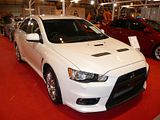
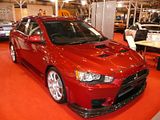 Aston-Martin V8 Volante
Aston-Martin V8 Volante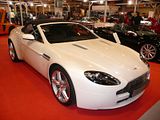 Porsche Cayenne, complete with signs staying “do not touch”, which is, of course, a recipe for everyone to put their sticky mits all over the vehicle, much to the chagrin of the stand security staff!
Porsche Cayenne, complete with signs staying “do not touch”, which is, of course, a recipe for everyone to put their sticky mits all over the vehicle, much to the chagrin of the stand security staff!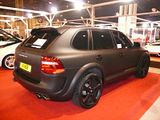 GBRacing
GBRacing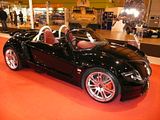 Invicta
Invicta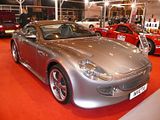 Pagani Zonda
Pagani Zonda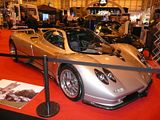
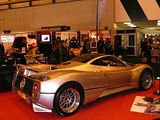 Aston-Martin DBS (courtesy of the Top Gear stand)
Aston-Martin DBS (courtesy of the Top Gear stand)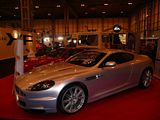 Lamborghini Murcielago Roadster
Lamborghini Murcielago Roadster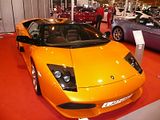 Trident
Trident Ferrari 430 Spider
Ferrari 430 Spider Lamborghini Gallardo
Lamborghini Gallardo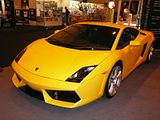 Mercedes McLaren SLR
Mercedes McLaren SLR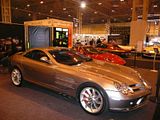 JetStream
JetStream And so, on to the heritage cars in this part of the show:
And so, on to the heritage cars in this part of the show: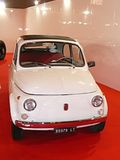
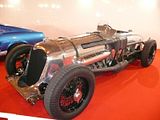
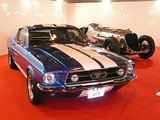
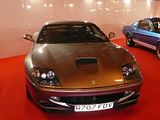
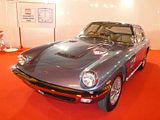
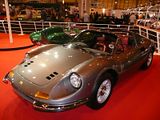 Lotus Eleven
Lotus Eleven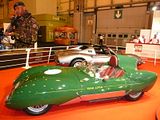 Jaguar “D” Type
Jaguar “D” Type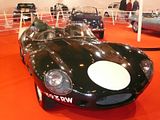
 And finally………. a British star, as this was a British Show. The incomparable 4.5 litre Bentley – a veritable super car of its era
And finally………. a British star, as this was a British Show. The incomparable 4.5 litre Bentley – a veritable super car of its era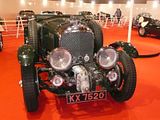
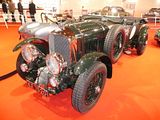 Doubtless much or all of the content of the Top Gear Live will soon be found on YouTube. Whether my personal contribution to the show – asked for an opinion on the Alfa-Romeo MiTo by one Jeremy Clarkson, who, on hearing that I do like Alfas, declared me to be “a man after his own heart” – will feature, I’m not sure. At least he got probably the only forummer from our group of attendees who would give a positive answer! A memorable couple of days, and thanks to the 9 forummers and Piers’ 3 friends who joined in and helped to make it such a fun event.
Doubtless much or all of the content of the Top Gear Live will soon be found on YouTube. Whether my personal contribution to the show – asked for an opinion on the Alfa-Romeo MiTo by one Jeremy Clarkson, who, on hearing that I do like Alfas, declared me to be “a man after his own heart” – will feature, I’m not sure. At least he got probably the only forummer from our group of attendees who would give a positive answer! A memorable couple of days, and thanks to the 9 forummers and Piers’ 3 friends who joined in and helped to make it such a fun event.2010-01-05 08:19:36































































































































































































































































































































































































































































































































